Biden leads in Michigan and Trump has one-point edge in Ohio
Some elections are just about "the economy," but despite the downturn, 2020 is about much more; there's just too much else happening. And while there's no big edge for either President Trump or former Vice President Joe Biden regarding who can revive the nation's economic fortunes, we do see glaring divisions over the matters shaping the nation's cultural and race relations and public health, all of which are strongly tied to vote, and which as of now accrue to Joe Biden's advantage.
While the president leads among Americans who approve of using of federal agents in U.S. cities, who are skeptical of the Black Lives Matter movement, and who continue to downplay the impact of the virus, all of those groups are outnumbered in America at the moment.
Instead, more Americans are very concerned about the virus. Most parents are wary of sending their children back to school in the face of it, and they feel the president doesn't care as much about the risks to their kids. Most Americans support the aim of the protests — and Biden leads among all of them.
In the upper Midwest, we see this playing out in two key states the president flipped from Democrats in 2016: Biden leads in Michigan by six points, and the president has the slightest one-point edge in Ohio, where he won by a comfortable margin four years ago. Ohio is also a critical part of the president's overall electoral map in 2020.
A majority of Biden's support in both these states comes from people who are mainly voting against Mr. Trump rather than for him.


Seventy percent of Michigan's registered voters dislike how the president handles himself personally. Biden only receives mixed support on this measure himself but still does better than Mr. Trump by double-digits.
Coronavirus impact
In Michigan in particular, views on how the president has handled the coronavirus appear to weigh on him: Many more say the Trump administration has hurt rather than helped the state's efforts to control the virus. And now, just as many want the administration to focus on containment as on economic recovery.

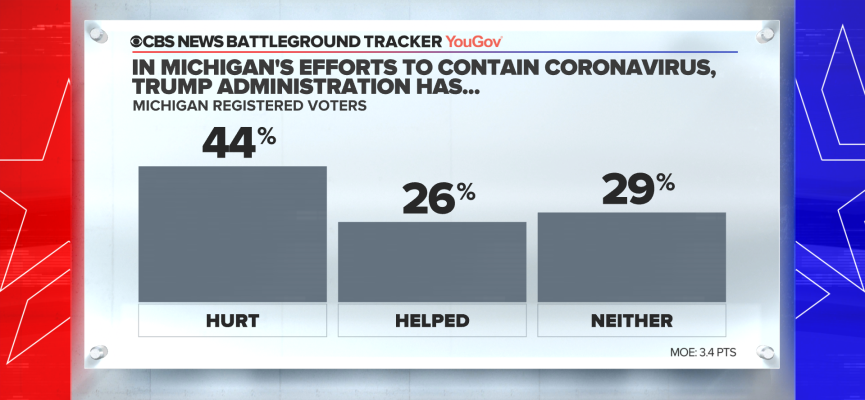
Republicans in Michigan are also comparably less likely than Democrats or independents to call coronavirus a factor in their presidential vote.
Six in 10 say things are going well in Michigan's efforts to deal with the outbreak of coronavirus, and Governor Gretchen Whitmer gets a 64% approval rating on her handling of it. That's higher than the 42% who give Mr. Trump positive marks on handling coronavirus. Two-thirds of Democrats in the state want Biden to consider her for vice president.

Any election with an incumbent is at least partly a referendum on the officeholder. Aside from Republicans, voters in Michigan and Ohio say the Trump presidency has not met their expectations. They are more likely to say it has gone worse than expected than better. And in both states, the president is underwater with independents on this measure. That's correlated with vote: the president draws almost no votes from independents who say it's going worse, and most of his votes come from those who say it's going better.
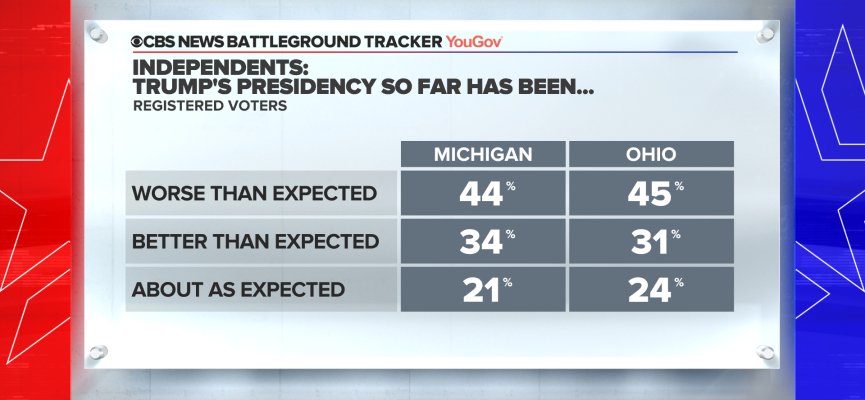
School reopening
Parents and schools around the country are wrestling with decisions over what to do this fall. And among parents, there's a perceived empathy gap between the candidates. Among parents of school-age kids nationwide, 63% feel Biden cares a lot or at least some about the virus' risk to children like theirs, compared to 48% who feel Mr. Trump does.
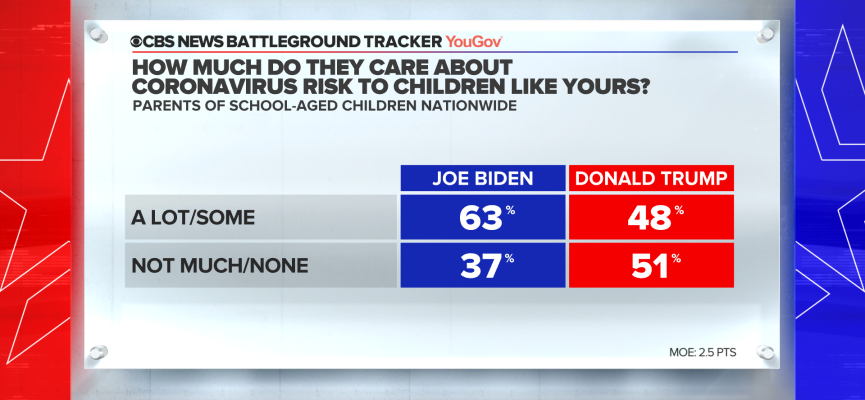
Despite calls from the Trump administration to reopen schools, most Americans, as well as most voters in Michigan and Ohio, don't think they should open as normal, with full classrooms. Instead, most want either a partial reopening (34% nationwide) or for schools to remain closed (46%).
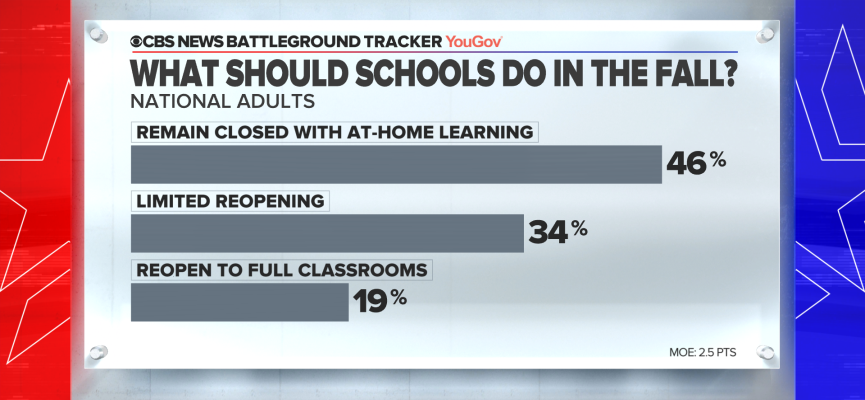
And even if schools were to reopen, just 32% of parents with school-aged children say they would send their kids, with 37% taking a wait-and-see approach, and 31% saying they would not. Those wary of schools reopening also describe the Trump administration as trying to put pressure on schools to reopen.

Economy
Assessments of the economy in Michigan and Ohio aren't good, but they're relatively better than how Americans see the national economy.
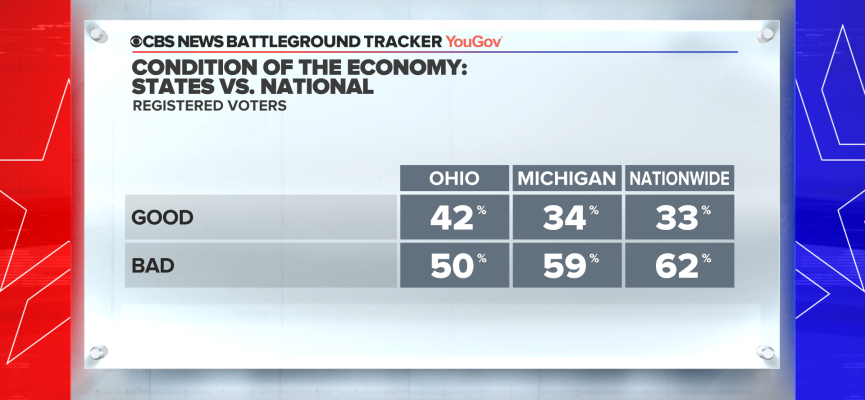
Michigan voters see a negative economic impact from the coronavirus outbreak but vary on how bad it'll be. Forty-six percent say it has had either little impact or the downturn will only be temporary, while 54% call it either a recession or a depression.
Neither candidate earns a big edge on economic matters, but relatively, Trump is viewed as better handling economic matters in Ohio than in Michigan, which helps explain his better overall numbers there today. (This also has echoes of 2016, when Trump also was seen as better on economics in Ohio, but not in Michigan.)
Looking forward, views are mixed on whether either candidate's policies would help recovery and are driven, as with many things, by partisan divides.
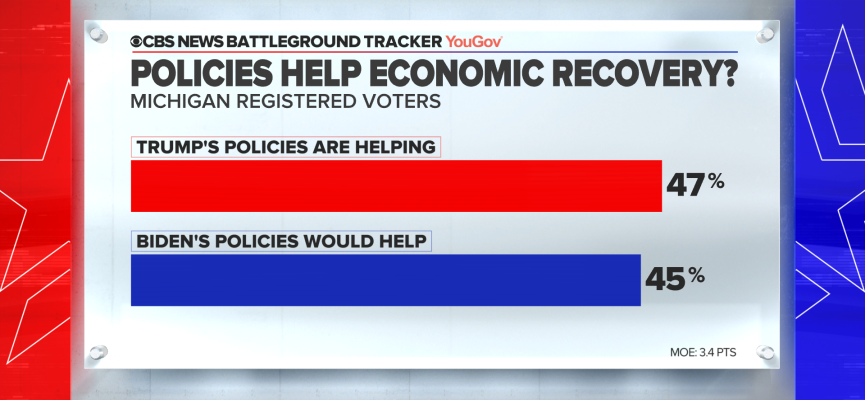
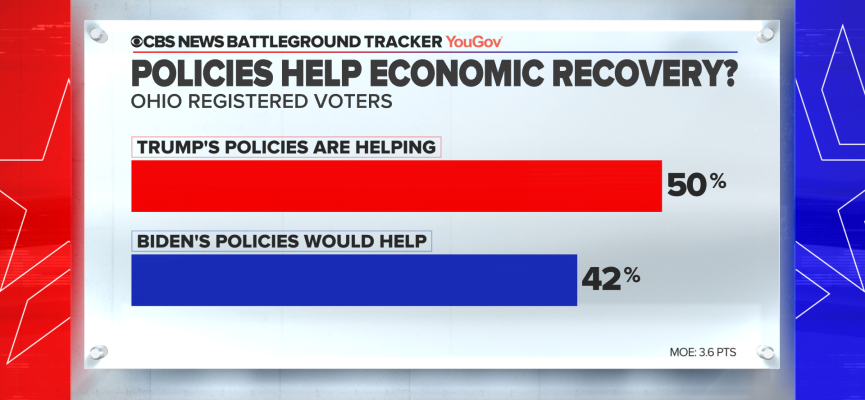
Empathy is always part of picking a candidate, and views are mixed on which candidate cares about your economic situation. Importantly, in both states, being seen as caring and as having effective policies are each correlated with vote choice. Mr. Trump elicits more polarized views than Biden on caring, with more people saying he either cares a lot or not much/not at all.
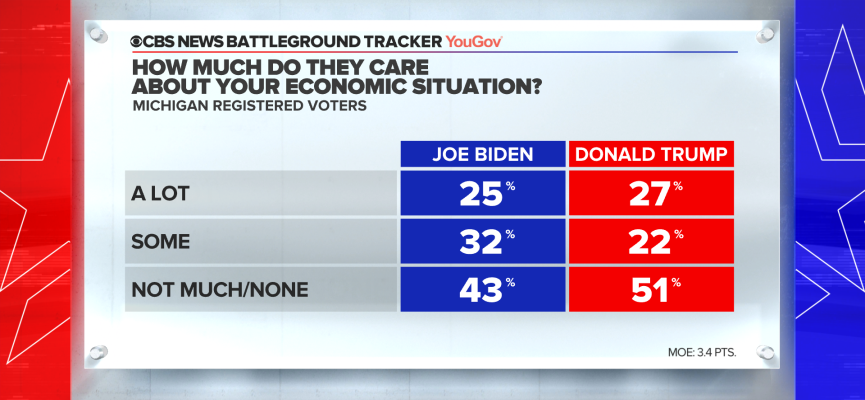
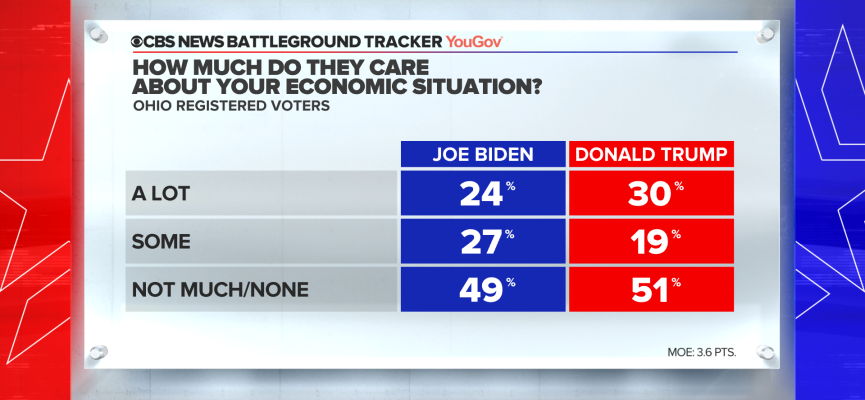
In both states, Mr. Trump is bolstered by support from White voters without college degrees, and in Ohio, he is seen as better at protecting manufacturing jobs.

If part of the Trump campaign's argument is reminding voters of how successful the economy was prior to the outbreak, that, too, might resonate a little more in Ohio than in Michigan, but it doesn't find much traction in either state. Looking back, somewhat more Ohio voters say his policies were helping than hurting, but in Michigan, that retrospective view is evenly mixed.
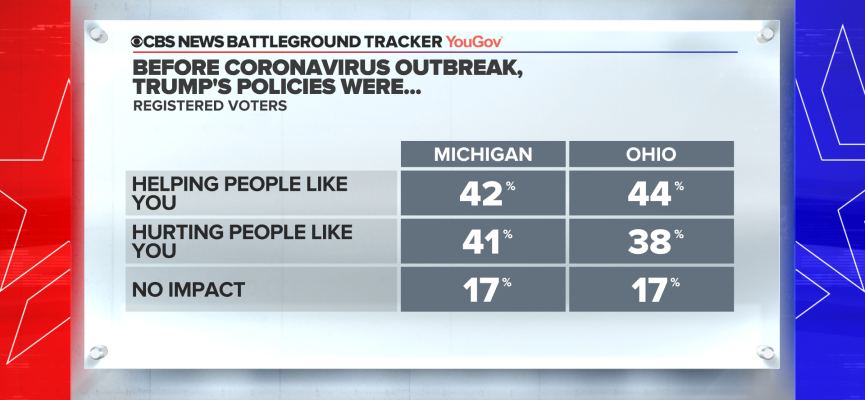
The horse race
While President Trump continues to lead among White men — a group he won in Michigan and Ohio in 2016 — it's now a much narrower lead in both states.

The story is similar with White voters without college degrees, more generally. In both states, they currently support the president by double-digit margins, but with over a third now saying they're voting Democratic, it's enough to make Ohio very competitive and would represent gains for the Democrats from last cycle if it came to pass.
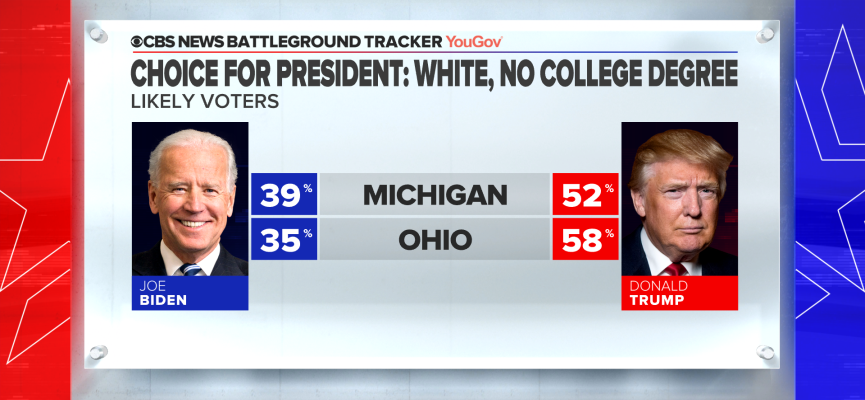
Biden has also gained among younger voters. In both states, he leads among those under age 45 by over 20 points, substantially building on Hillary Clinton's margins four years ago.
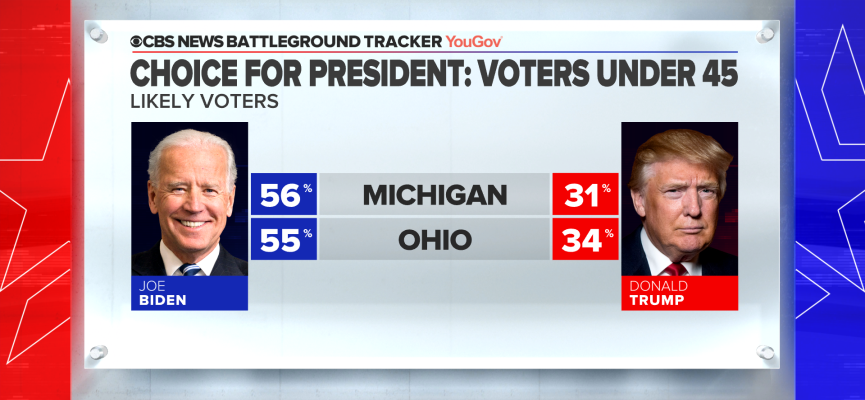
Biden currently has a double-digit leads among white women with a college degree in these states — a group Clinton lost to Mr. Trump in Ohio and won by just six points in Michigan.

In Michigan, Biden has a lead among those calling themselves independent, has reversed Mr. Trump's 2016 lead with White women and is cutting into his margins with seniors. He's also adding some voters who say they'll show up this time — which is a political story as much as a polling one, since Biden's fortunes do partly depend on turning out younger and first-time voters here. There's no enthusiasm gap in Michigan — six in ten of both candidates' supporters are enthusiastic about voting.
Nationally, Biden leads Mr. Trump by 10 points among likely voters. But the national vote tally doesn't determine the presidency. The Electoral College does.
CBS News Battleground Tracker mapThe protests
We asked voters in Michigan and Ohio what the focus of the Trump administration ought to be right now, given their expressed aims. At the top of the list of what is most important, voters ranked stopping the spread of the virus and getting economic relief to people as top goals, more than twice as many as wanted them to limit Black Lives Matter protests. Even among Republicans, who tend to agree with the president on protests, the virus and economic relief ranked higher in importance.
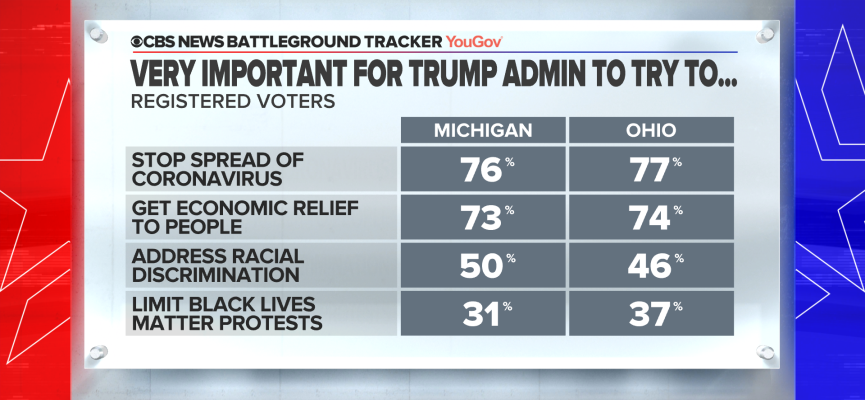
Nationwide, as well as in Ohio and Michigan, more Americans agree with the ideas expressed by Black Lives Matter than disagree with them. This is sharply divided by partisanship and is strongly correlated with vote. So, too, is the president's current handling of protests, more generally. His voters strongly approve, and Biden's voters do not.

Nationally, we see a majority who feel dealing with protests and demonstrations ought to be left to local law enforcement (61%), rather than the federal government getting involved (39%). It's most conservatives who say the federal government ought to, though a third disagree; and over 80 percent of liberals pick local law enforcement.
On the specific protests in Portland, we find more even splits nationwide. Here it's very clear along partisan lines, with Republicans and conservatives strongly in approval, and Democrats and liberals against.
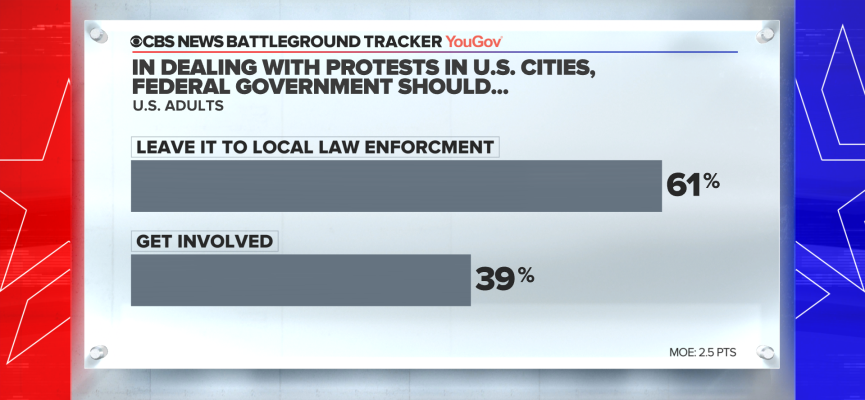

Surveys were conducted on behalf of CBS News by YouGov between July 21-24, 2020. They are based on representative samples of 1,177 registered voters in Michigan and 1,227 in Ohio. Margins of error for registered voters: Michigan +/- 3.4 points, Ohio +/- 3.6 points. The national survey was conducted among a nationally representative sample of 2,008 U.S. adult residents. The margin of error for U.S. adults is 2.5 pts.
Battleground tracker toplines:
Hurricane Hanna makes landfall in South Texas, expected to dump several inches of rain

